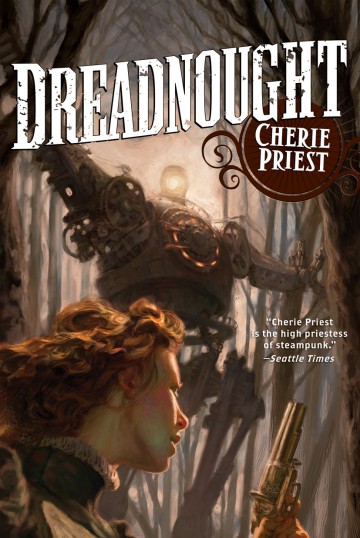Cherie Priest, Dreadnought
reviewed by Danielle L. Parker

Dreadnought Publisher: Tor, 2010 Length: 400 pp. ISBN: 978-0-7653-2578-5 |
But steampunk is a genre whose time seems now not so much passé as never really here. Cherie Priest’s competently written book, Dreadnought, exemplifies all the reasons why the sub-genre soon proved such a disappointment, at least to this reader.
In Dreadnought, Mercy Lynch, a newly widowed nurse working in a Confederate hospital in an alternate-history Civil War, gets a message from her long-lost, given-up-for-dead daddy. Daddy is dying. He wants to see his daughter before he expires. It won’t be an easy journey for Mercy. Daddy’s in Washington state, which means Mercy will have to travel via train and airship (crazy hydrogen-powered airship, no less) across a war-torn continent.
But Mercy gives up her job and embarks on her epic adventure. After her airship crashes in the front lines of battle, where giant iron men battle it out for Union and Confederacy, Mercy somehow finds herself on a special huge armored Union train, the Dreadnought. The Dreadnought is crowded with grim Union soldiers, and two of the cars in the train are in top-secret lockdown. Soon, both raiders and a speedy Confederate train, the Shenandoah, are in pursuit. The climactic battle happens as the two trains confront each other in the mountain passes of the Rockies.
Priest is a competent writer with an eye for believable settings and a gift for drawing secondary characters in sharp outline. But perhaps her competency only highlights the reasons steampunk soon lost my interest.
First of all, there’s the tired clichés. Mad Scientist? Check, got him. Steam-powered iron behemoths? Check. Zombies? Check. Climactic battle against flesh-eating zombies? Double-check. It’s a shame Priest limits herself to the familiar flourishes. She’s too good (though Priest’s penchant for disappearing characters left this book ending flat).
You can be forgiven for forgetting, after you’ve encountered the umpteenth steampunk example of flesh-eating zombies, iron engines and mad scientists, how innovative and visionary H. G. Wells, Mary Shelley, and Jules Verne really were. And even now, there’s nothing out there close to Mervyn Peake’s Gormenghast books. (Having read every massive tome in the series, I can almost say: what a relief).
But that, I suppose, is why steampunk ultimately failed to interest me. Fun escapist stuff, but I wish they’d stop repeating those zombies. Like the corsets so often found in its alternate-history pages, the genre is strait-jacketed into its limitations. Steampunk, unlike the writing of its quoted founding fathers, is more surface than substance, more cliché than visionary. Too bad.
Copyright © 2011 by Danielle L. Parker

